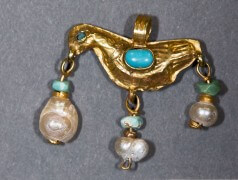The skeleton was discovered under the shingles of the collapsed roof discovered in the excavations in Susita and is silent testimony to the earthquake of 363 * "Finally the data is starting to come together into a clear historical-archaeological picture," said Dr. Michael Isenberg, head of the expedition

Silent testimony to the great earthquake of 363 AD - a woman's skeleton with a gold pendant in the shape of a dove on it under the roof tiles that collapsed was discovered during the current season of excavations by Haifa University researchers in Susita. Also discovered this season: a muscular leg larger than marble and the artillery ammunition of 2000 years ago. "Finally the data is starting to come together into a clear historical-archaeological picture" said Dr. Michael Isenberg, head of the international delegation of the excavations.
For the past 15 seasons, the excavations conducted by the researchers of the Zinman Institute of Archeology at the University of Haifa in Susita (Hipos) never cease to provide fascinating findings. Over the years, the expedition that excavates the city located east of the Sea of Galilee, in the Susita National Park of the Nature and Parks Authority, has grown, with more teams and diggers from different countries, when this time the security situation in the south "sent" to them as reinforcements a Canadian delegation led by Dr. Stephen Chambers ).
Susita, founded in the second century BC, experienced two powerful earthquakes that are well documented - the first in 363 AD, which caused great destruction from which the city recovered, and the great earthquake of 749 which destroyed the city and Nietzsche was never seen again. Evidence of the great destruction of the earthquake of the year 363 was already found in previous seasons, but none of them were as violent, exciting and chilling as the one revealed this year. To the north of the basilica, the largest building in the city that served as the commercial, economic and judicial area of the city, the director of the excavation area, Chaim Shkolnik, and his team discovered the remains of several skeletons, crushed under the weight of the roof that collapsed on them, with a gold pendant in the shape of a dove resting between the bones of one of the women.
Evidence was found for the first time this year, that the great earthquake of the year 363 destroyed the Roman bathhouse, which was excavated by the team led by Arlata Kowalska from Poland and, like the basilica, it was not rebuilt either. According to Dr. Isenberg, according to the evidence they have found so far, the noise was so strong that it completely destroyed the city and it needed about twenty years to regenerate. Among the ruins of the bath house, a muscular right leg of a man was discovered resting on a tree trunk, an excellent sculpture in marble. "It is too early to identify who the sculpted man is. We may have before us a god or an athlete whose statue reached over 2 meters in height. We hope to find more parts of the statue in the coming seasons that will shed light on its identity," said Dr. Isenberg.
In the renewed excavations at the bastion, the city's main defensive position from the Roman period, which was erected on the edge of the southern cliff, the work focused on a protected position for a machine for launching the stones of the lystra, which according to the size of the hall was about eight meters long. So far, researchers have found a number of lystra stones that fit the giant launcher, as well as smaller basalt balls, which were used by the smaller machines. Launching machines of this kind and larger ones that were placed above the bastion vaults fired basalt ballistic balls of a size slightly smaller than a football to an effective distance of about 350 m.
A section of the western part of the main colonnaded street of the city, which crosses it in its entire length almost 600 m from east to west (the decomnus maximus) was excavated this year with the assistance of the Canadian delegation, whose planned excavation was canceled in the south of the country. The researchers found another original section of the wall that carried the columns of the street, which confirms the explanation that it was a magnificent columned street, similar to the cities of the Roman East, which were built during the height of Roman peace in the first centuries AD.
At the same time as the archaeological work, the expedition made a huge investment in the preservation of the site. "I am definitely proud that this year we were able to organize a conservation expedition that was the largest in scope, and all this from internal budgets and assistance from the Western Galilee Academic College in Acre. 22 students from the conservation department from the college in addition to five experienced conservationists under the direction of Yulia Burdewicz from the National Academy of Arts in Warsaw won the conservation job. This is one of the main tourist sites in the north of the country, so I see this as a national mission, even if the budget for this rests mainly on our own sources and without any government support," concluded Dr. Isenberg.
More of the topic in Hayadan:
- An archaeological mystery at the University of Haifa excavations in the ancient city of Susita: what is a modern cork of beer doing in a closed drainage channel from 2000 years ago?
- A look at the differences between the classes in the ancient world
- A hoard from the fourth century was discovered in Susita

One response
Hahhhhhhhh
It looks too new